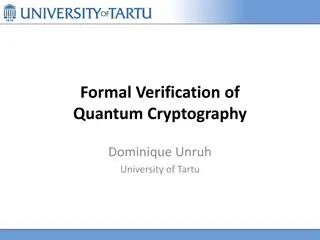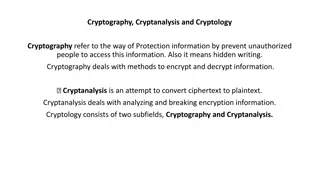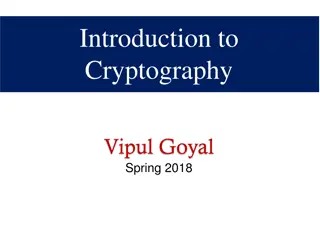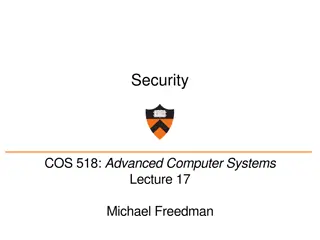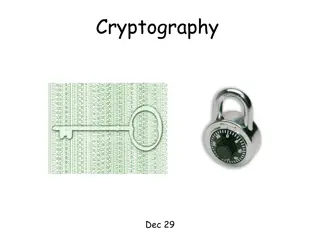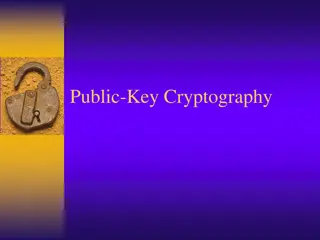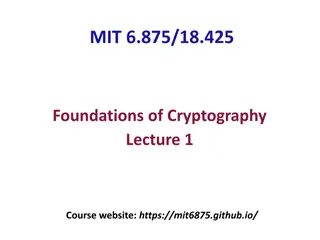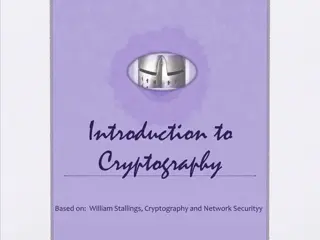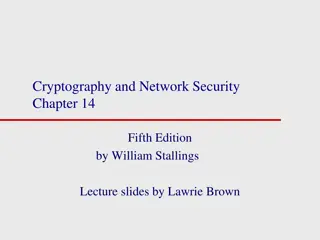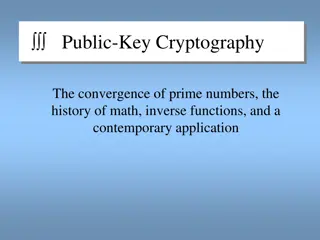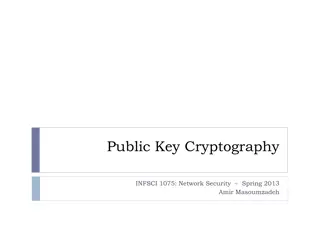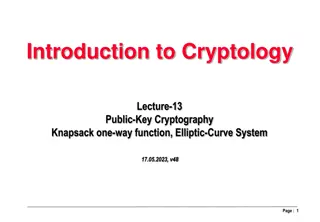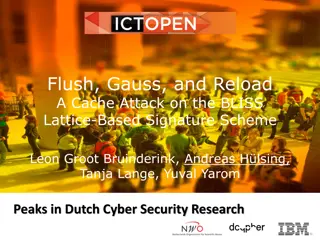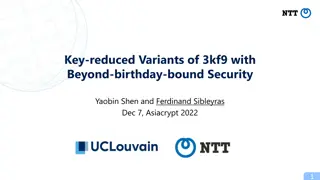The Fascinating World of Cryptography
Cryptography is the art of concealing messages to ensure information security, involving processes like encryption and cryptanalysis. Explore the history of cryptography from ancient civilizations to modern-day techniques like steganography. Witness the evolution of coding methods and machines that revolutionized information security, including during World War II. Delve into the origins and complexities of this intricate field that plays a crucial role in data protection and communication privacy.
Download Presentation

Please find below an Image/Link to download the presentation.
The content on the website is provided AS IS for your information and personal use only. It may not be sold, licensed, or shared on other websites without obtaining consent from the author.If you encounter any issues during the download, it is possible that the publisher has removed the file from their server.
You are allowed to download the files provided on this website for personal or commercial use, subject to the condition that they are used lawfully. All files are the property of their respective owners.
The content on the website is provided AS IS for your information and personal use only. It may not be sold, licensed, or shared on other websites without obtaining consent from the author.
E N D
Presentation Transcript
CRYPTOGRAPHY CRYPTOGRAPHY Cryptography is the process of making and using codes to secure the transmission of information. The art and science of concealing the messages to introduce secrecy in information security is recognized as cryptography. The word cryptography was coined by combining two Greek words, Krypto meaning hidden and graphene meaning writing. Cryptanalysis is the process of obtaining the plaintext message from a ciphertext message without knowing the keys used to perform the encryption. Cryptology is the science of encryption, which encompasses cryptography and cryptanalysis.
History of Cryptography History of Cryptography The roots of cryptography are found in Roman and Egyptian civilizations. The art of cryptography is considered to be born along with the art of writing need of people to communicate secretly with selective recipient in turn ensured the continuous evolution of cryptography Hieroglyph The Oldest Cryptographic Technique Some 4000 years ago, the Egyptians used to communicate by messages written in hieroglyph. This code was the secret known only to the scribes who used to transmit messages on behalf of the kings.
Later, the scholars moved on to using simple mono-alphabetic substitution ciphers during 500 to 600 BC. This involved replacing alphabets of message with other alphabets with some secret rule. This rule became a key to retrieve the message back from the garbled message. Caesar Shift Cipher The earlier Roman method of cryptography Involve shifting the letters of a message by an agreed number the recipient of this message would then shift the letters back by the same number and obtain the original message
Steganography Steganography Here people not only want to protect the secrecy of an information by concealing it, but they also want to make sure any unauthorized person gets no evidence that the information even exists. E.g. invisible watermarking. In steganography, an unintended recipient or an intruder is unaware of the fact that observed data contains hidden information. In cryptography, an intruder is normally aware that data is being communicated, because they can see the coded/scrambled message.
Evolution of Cryptography Evolution of Cryptography 15th century, Improved coding techniques e.g Vigenere Coding offered moving letters in the message with a number of variable places instead of moving them the same number of places After the 19th century, cryptography evolved from the ad hoc approaches to encryption to the more sophisticated art and science of information security In the early 20th century, the invention of mechanical and electromechanical machines, such as the Enigma rotor machine, provided more advanced and efficient means of coding the information. During the period of World War II, both cryptography and cryptanalysis became excessively mathematical. Government organizations, military units, and some corporate houses started adopting the applications of cryptography They used cryptography to guard their secrets from others
Modern Cryptography Its foundation is based on various concepts of mathematics such as number theory, computational-complexity theory, and probability theory. Classic Cryptography Modern Cryptography It manipulates traditional characters, i.e., letters and digits directly It operates on binary bit sequences It is mainly based on security through obscurity . The techniques employed for coding were kept secret and only the parties involved in communication knew about them It relies on publicly known mathematical algorithms for coding the information. Secrecy is obtained through a secrete key which is used as the seed for the algorithms. The computational difficulty of algorithms, absence of secret key, etc., make it impossible for an attacker to obtain the original information even if he knows the algorithm used for coding It requires the entire cryptosystem for communicating confidentially Modern cryptography requires parties interested in secure communication to possess the secret key only
Security Services of Cryptography Security Services of Cryptography The objective of using cryptography is to provide the following four fundamental information security services: Confidentiality It is a security service that keeps the information from an unauthorized person. It is sometimes referred to as privacy or secrecy. Data Integrity It is security service that deals with identifying any alteration to the data. Authentication Authentication provides the identification of the originator. It confirms to the receiver that the data received has been sent only by an identified and verified sender. Non-repudiation It is a security service that ensures that an entity cannot refuse the ownership of a previous commitment or an action. It is an assurance that the original creator of the data cannot deny the creation or transmission of the said data to a recipient or third party.
Cryptography Primitives Cryptography Primitives Cryptography primitives are nothing but the tools and techniques in Cryptography that can be selectively used to provide a set of desired security services. Encryption Hash functions Message Authentication codes (MAC) Digital Signatures
Cryptographic Attacks Cryptographic Attacks Attacks on cryptosystems are categorized as follows: Ciphertext Only Attacks (COA) In this method, the attacker has access to a set of ciphertext(s). He does not have access to corresponding plaintext. COA is said to be successful when the corresponding plaintext can be determined from a given set of ciphertext. Known Plaintext Attack (KPA) In this method, the attacker knows the plaintext for some parts of the ciphertext. The task is to decrypt the rest of the ciphertext using this information. E.g. linear cryptanalysis against block ciphers. Chosen Plaintext Attack (CPA) Here, the attacker has the text of his choice encrypted. So he has the ciphertext- plaintext pair of his choice. This simplifies his task of determining the encryption key. An example of this attack is differential cryptanalysis applied against block ciphers as well as hash functions. A popular public key cryptosystem, RSA is also vulnerable to chosen-plaintext attacks.
Dictionary Attack This attack has many variants, all of which involve compiling a dictionary . In simplest method of this attack, attacker builds a dictionary of ciphertexts and corresponding plaintexts that he has learnt over a period of time. In future, when an attacker gets the ciphertext, he refers the dictionary to find the corresponding plaintext. Birthday Attack This attack is a variant of brute-force technique. It is used against the cryptographic hash function. When students in a class are asked about their birthdays, the answer is one of the possible 365 dates. Let us assume the first student s birthdate is 3rd Aug. Then to find the next student whose birthdate is 3rdAug, we need to enquire 1.25* 365 25 students. Similarly, if the hash function produces 64 bit hash values, the possible hash values are 1.8x10(19). By repeatedly evaluating the function for different inputs, the same output is expected to be obtained after about 5.1x10(9) random inputs. If the attacker is able to find two different inputs that give the same hash value, it is a collision and that hash function is said to be broken.
Brute Force Attack (BFA) In this method, the attacker tries to determine the key by attempting all possible keys. If the key is 8 bits long, then the number of possible keys is 28= 256. The attacker knows the ciphertext and the algorithm, now he attempts all the 256 keys one by one for decryption. The time to complete the attack would be very high if the key is long. Man in Middle Attack (MIM) The targets of this attack are mostly public key cryptosystems where key exchange is involved before communication takes place. Host A wants to communicate to host B, hence requests public key of B. An attacker intercepts this request and sends his public key instead. Thus, whatever host A sends to host B, the attacker is able to read. In order to maintain communication, the attacker re-encrypts the data after reading with his public key and sends to B. The attacker sends his public key as A s public key so that B takes it as if it is taking it from A.
Side Channel Attack (SCA) This type of attack is not against any particular type of cryptosystem or algorithm. Instead, it is launched to exploit the weakness in physical implementation of the cryptosystem. Timing Attacks They exploit the fact that different computations take different times to compute on processor. By measuring such timings, it is be possible to know about a particular computation the processor is carrying out. For example, If the encryption takes a longer time, it indicates that the secret key is long. Power Analysis Attacks These attacks are similar to timing attacks except that the amount of power consumption is used to obtain information about the nature of the underlying computations. Fault analysis Attacks In these attacks, errors are induced in the cryptosystem and the attacker studies the resulting output for useful information
References [1] Principle of Information Security by Michael E. Whitman, 5th Edition, Herbert J. Mattord. [2] Network Security Essentials: Applications and Standards, 4th Edition, William Stallings.







